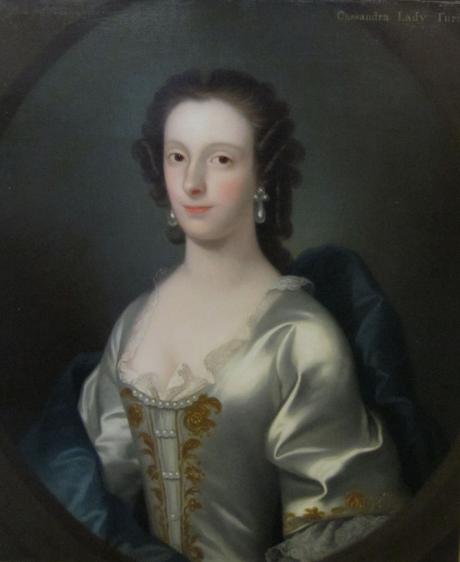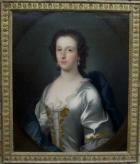"W Smith Pinxt"
The Page-Turner Estate
Midlington Park, No 28
M. Maclean, Esq
Southampton Art Gallery, 'Local artists of the 18th/19th Centuries', May 1978.
Cassandra Leigh of Adlestrop, afterwards Lady Turner , was born 11 April 1723 and christened 25 April 1723 in Westminster, London. She was the daughter of William Leigh of Adlestrop and Mary Lord . She was the niece of the Master of Balliol College . She married Sir Edward Turner 2nd Bt on the 8 September 1739 in Adlestrop. She died 18 October 1770. She was mother of 9 children (4 dying at chidbirth) : Cassandra Turner who married Martin Bladen Hawke, 2nd Baron Hawke of Towton , Elizabeth Turner who married Maj.-Gen. Thomas Twisleton, 7th Baron Saye and Sele, Gregory Turner who became Sir Gregory Page-Turner, 3rd Bt., William Turner and John Turner who became Sir John Dryden, his name was legally changed to John Dryden by Royal Licence.
Cassandra Married Sir Edward Turner, 2nd Baronet (1719–1766) was one of the Turner baronets of Ambrosden and a Member of Parliament.
Turner was the son of Sir Edward Turner, 1st Baronet and his wife Mary. He received his early education at Bicester Grammar School. He went on to Balliol College, Oxford where he was noted for his "distinguished scholarship and the regularity of his behaviour". He married Cassandra Leigh, niece of the Master of Balliol.He became 2nd Baronet on the death of his father in 1735. Turner died in 1766 and was succeeded in the baronetcy by his son Sir Gregory Page-Turner, 3rd Baronet.
In about 1740 Turner replaced Ambrosden manor house with a large square country house of eleven bays. His architect was Sanderson Miller, who also designed ornamental buildings in the grounds. A landscaped park 5 miles (8.0 km) in circumference was laid out around the house. The park was ornamented with lakes and statues, and the drive to the house was along a semicircular avenue of trees.
Turner's new house became a meeting-place for politicians and cultivated society. Cassandra's uncle Dr. Leigh and other wits and learned men from the University of Oxford were frequent visitors.
In 1741 Turner built a new road between Ambrosden and Merton, Oxfordshire. He intended to continue it to Oxford but the remainder of the project was never executed. The road was reputed to cost a guinea a yard. The road includes a completely straight stretch of about 1.5 miles (2.4 km). It runs across level ground but its course undulates at regular intervals, apparently intended to help draught animals pull vehicles.
In 1740 Sir James Harington, 6th Baronet, who had accrued large debts by gambling, mortgaged his estate at Merton to Turner. Harington was a Jacobite and in 1747 fled into exile to join Charles Edward Stuart. In 1749 Turner foreclosed the mortgage and thereby obtained the manor of Merton. As Turner had just had a great house built for himself at Ambrosden, Turner had no need of the 16th century manor house at Merton, so he had one wing demolished and the other turned into a farmhouse.
Turner was elected MP for Great Bedwyn in Wiltshire in the 1741 General Election but was not re-elected in the 1747 General Election.
In the 1754 General Election Turner stood as one of the two Whig candidates for Oxfordshire. Both they and their Tory opponents for the Oxfordshire Election 1754 spent great sums of money on their campaigns, including providing lavish hospitality for electors to try to win their votes. Both parties' candidates were supported by local aristocrats. Turner and his running-mate, Viscount Parker were supported by the Duke of Marlborough, Earl Harcourt and Parker's father the Earl of Macclesfield.
The two Tory candidates won more votes but the returning officer made a "double return": declaring both pairs of candidates to be elected, leaving the House of Commons to make the decision. Both sides petitioned against the election of their opponents and the Commons examined the legitimacy of many of the individual votes. However, most MPs voted on partisan lines rather than on the merits of the case. The Whigs held a majority in the House of Commons, and therefore the two Whig candidates were declared elected.
Turner did not defend the Oxfordshire seat in the 1761 General Election. Instead he successfully stood for Penryn in Cornwall. In 1764, he purchased the manor of Wendlebury, Oxfordshire from the trustees of the 3rd Earl of Abingdon. Sir Edward died in 1766 while still an MP.
The monument in Ambrosden Church to Sir Edward Turner and his Wife Cassandra Turner has the following inscription : Under this chancel in a family-vault are deposited the remains of Sir Edward Turner Bart. and Dame Cassandra his wife, late of Ambrosden Park in this county; He died October 31st 1766, she; October 18th 1770, aged each 48 years. He was representative in three parliaments; one for this county. He exerted himself as an active and vigilant magistrate; adopted early in life the noblest political principles, and persevered in them to the end. He was learned without vanity, religious without ostentation and excelled in the great characters of husband, father and friend. His sorrowful widow (eldest daughter of William Leigh Esq. of Adlestrop in the county of Gloucester) was beautiful in person and engaging in her manner; won the esteem of all who knew her. A shining example of conjugal affection and every Christian virtue. To her children, an indulgent mother; to servants, a kind mistress; to the poor, living and dying, a compassionate benefactress. As a memorial to posterity, of some, only, of the many virtues of this excellent pair, their five surviving children: Sir Gregory Turner Bart. William Turner Esq. John Turner Esq. Elizabeth wife of Thomas Twisleton Esq. of Broughton Castle in this county and Cassandra wife of Martin Bladen Hawke Esq. eldest son of the right hon. Sir Edward Hawke K.B. have erected this monument..
William Smith (1706/7–1764), painter, was the elder brother of George Smith. He was thought to have been born at Guildford, Surrey. Placed by the duke of Richmond with a portrait painter in St Martin's Lane, London, he practised portraiture, first in London and then for eight or nine years at Gloucester. After his return to London he also painted fruit and flowers with success, exhibiting at the Free Society until his health deteriorated, when he retired to Shopwyke, near Chichester. There he died, apparently unmarried, on 27 September 1764, aged fifty-seven, and was buried on 29 September at Litten cemetery, St Pancras, Chichester. He was Brother of George Smith, (1713/14–1776) a landscape painter, and John Smith (1716/17–1764), who were both succesful artists.



